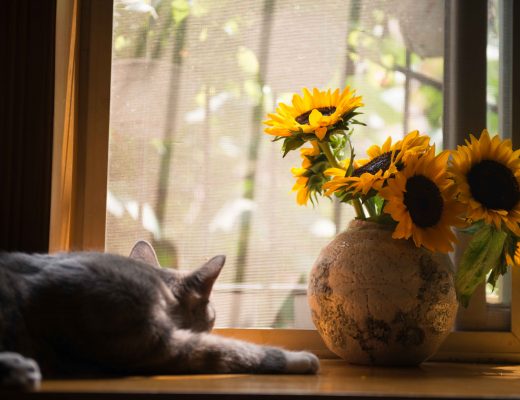Whether you live in a cold climate or in a hot and dry one, choosing the appropriate plants can be a challenge. The first thing that you need to consider when selecting your plants is the local conditions. By understanding the surrounding environment and the local climate, you have better chances to pick hardy plants that will survive without too much effort on your part.
People who live in mild climates are quite lucky in this regard and they grow almost any type of plants. However, for those of us who live within harsh climates, further research is recommended.
To save you the trouble, we’ve created this guide that is going to help you make an informed choice when it comes to creating a beautiful and low-maintenance garden. We’ll share plenty of examples of plants that can survive hot weather and drought and plants that are cold-hardy and we’ll give you a little insight into how to grow them and how to care for them.
What is a Hardy Plant?
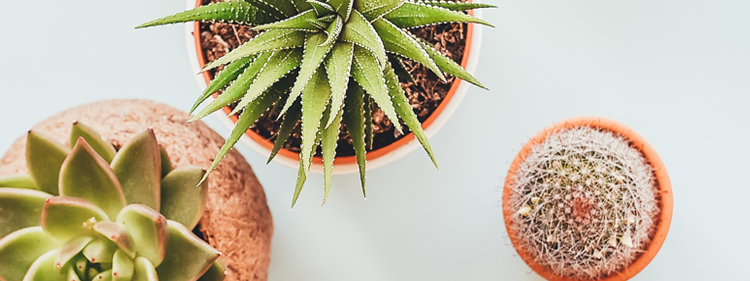
A hardy plant is a plant that will survive in an inhospitable environment. For instance, in cold climates, hardy plants will withstand low temperatures and frost. As a general rule, plants that are labelled as ‘hardy’ can survive temperatures as low as -15°C.
Plants labelled as ‘frost hardy’ can survive frost and temperatures as low as -5°C but not extremely low temperatures. Other hardiness labels include ‘half-hardy’ for plants that won’t survive temperatures below 0°C and ‘tender’ for plants that need a warm environment and won’t survive temperatures below +5°C.
Australian Climate and Hardy Plants
Australia is a large country and it has many different climate zones. This means that each region comes with specific environmental conditions. Northern Australia has a rather tropical climate with hot and humid summers and mild winters, so gardeners here don’t really need to worry about hardiness.
Southern Australia, is more temperate and a bit colder during winters, so it’s best to choose hardy and half-hardy plants here. Mountainous Southeastern Australia has a typical alpine climate which only allows for growing cold-hardy plants. The desert and bush areas, also known as ’outback’ Australia are extremely hot and dry with temperatures that reach 50°C, so only drought-hardy plants can survive this environment.
How to Choose Hardy Plants for Your Garden?

If you’re starting a garden, you might feel like you’re dealing with an overwhelming project, especially if you’re not an expert gardener. But if you choose hardy plants that will thrive in the local conditions, gardening will become a much easier activity.
So, before you purchase the seeds, take some time to consider the unique environmental conditions of your garden. Once you have these figured out, you can find the plants that have the best chances of survival and that will grow healthy and happy without too much effort on your part.
Choose plants that thrive in your climate
As mentioned above, if you live in a region with cold winters, hardy plants such as Amsonia, Delphiniums, Hibiscus, etc. are great options. For temperate regions, we recommend resilient, hardy and semi-hardy flowers and shrubs that are equipped to survive sudden temperature fluctuations and freezing temperatures.
If you live in a region with a tropical or subtropical climate, you need to focus on growing heat and drought-tolerant plants such as aloes and euphorbias.
Humid and warm environments are perfect for species that thrive in steamy conditions such as orchids and amaranths.
Plants that have thick, waxy leaves can survive without water for long periods of time, which makes them better suited for warm environments.
How to grow hardy native plants
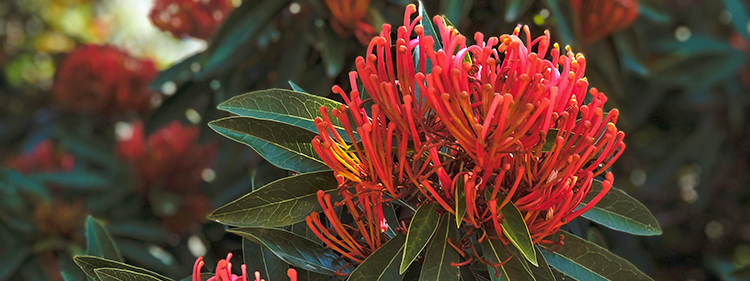
Growing native plants has so many advantages and zero disadvantages. Needless to say, native plants will thrive in your garden as they are perfectly adapted to the conditions found in your region.
By growing native plants you won’t have to use fertilizers or pesticides, so your garden will be more environmentally friendly. Also, native plants will attract beneficial insects and pollinators to your garden and will make your garden a friendlier ecosystem.
Take the average amount of rainfall into account
When choosing hardy plants, it is important to consider the precipitation levels in your region. The amount of rain and humidity that your plants receive will determine their development.
Keep in mind that gardens that get a lot of rain won’t need additional watering, while gardens that enjoy the hot sun will require regular and abundant watering. Some species of flowers such as verbena and cotyledon will get drowned in a storm as they don’t like to get wet.
To avoid drowning your plants, try to match their water needs with the average amount of rain in your region.
Be prepared for frost
If you don’t want frost to take you by surprise, you can find out when the first and last frosts of the season occur on average by doing some extra research. There are many planting guides available online created for each region of the country, so a quick search might save you the trouble of choosing plants that won’t survive.
How to Read the Label of Hardy Plants?
To master the art of choosing hardy plants, you need to be able to read the label correctly. A plant can be labelled as a:
- Hardy Perennial – A plant that’s labelled as a ‘Hardy Perennial’ can withstand low temperatures during the winter and it will reemerge on a yearly basis for several years.
- Hardy Biennial – This plant will also survive an average winter. It will develop strong roots and leaves during its first year, and it will flower and produce seed during its second year, after which it will die off.
- Hardy Annual – For this type of plant, the process of seed sowing to seed-producing will take one year. Hardy annuals can also withstand cold temperatures, so they will survive winter and bloom in early summer.
Quick Tip: In many cases, the plant’s packaging will only include the name of the plant without any additional details. In this situation, a quick search online will tell you whether the plant is suitable for your region or not. Purchase the plant after you’ve done some research.
Hardy Plants for Cold Climates
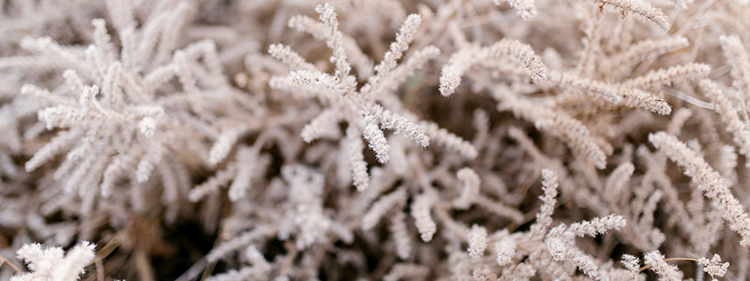
Just because the weather is getting chillier, that doesn’t mean that we have to say goodbye to the beauty and vitality of our garden. There are many hardy plants that can survive cold winters, that won’t die off, and that will reemerge in spring. So, before the freezing temperatures arrive, make sure you fill your garden with these tough, reliable, cold-hardy perennials that won’t mind the occasional polar vortex and will reward you with their blooms for many years.
Blue Honeysuckle

Lonica Cerulea a.k.a Blue Honeysuckle, Sugar Mountain, Honeyberry, or Fly Honeysuckle is a deciduous shrub that grows natively in the cool temperate countries of the Northern hemisphere (Poland, Russia, Japan, Canada, etc.). The fruits produced by the Blue Honeysuckle are sweet and edible, so this hardy plant can be grown as an edible shrub.
Blue Honeysuckle thrives in average soil types, and it prefers getting plenty of sunlight. It is a cold-hardy plant that produces yellow flowers in spring that will attract butterflies, bumblebees, and other pollinators. For optimal fruit production, it’s best to plant two or more varieties of Blue Honeysuckle. If you can only accommodate just one, don’t worry, these shrubs are considered self-fertile.
Peony Poppies
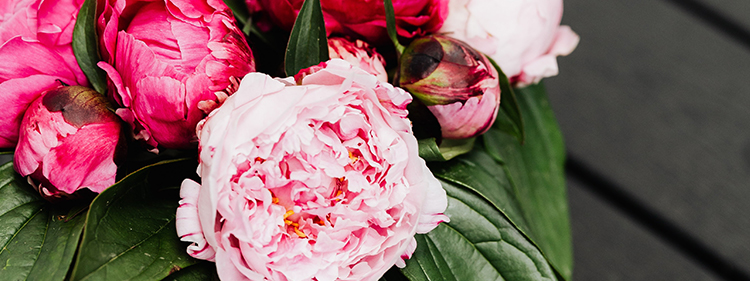
Papaver Paeoniflorum, commonly referred to as the peony poppy is an annual ornamental flowering plant that thrives in temperate climates. This mesmerizing and resistant plant is also known as the double garden poppy because it produces 4 to 5 inches (10 – 12 cm) double blooms. The blooms of the peony poppy have a papery appearance and the foliage is also attractive, having feathery edges.
Peony Poppies thrive in full sun as long as they get well-draining soil that’s rich in organic matter. For best results, start your peony poppies from seed, indoors, or in loosened, raked soil outdoors. The seeds don’t need to be covered with soil, they just need to be pressed gently by hand or by walking over the area, if you plant them outdoors.
Peony poppies bloom sporadically from late spring to early fall, and they attract bees, butterflies, and birds. All parts of the peony poppy are poisonous, so make sure you plant them within a safe distance from your kids and pets.
Lily of the Valley
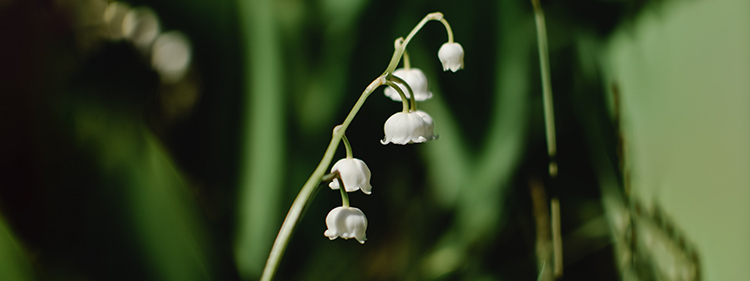
Convallaria majalis, a.k.a. Lily of the Valley, is a woodland flowering plant, native to the Northern hemisphere, that produces delicate, sweetly scented white flowers. It is worth mentioning right off the bat, that Lily of the Valley contains cardiac glycosides, which are extremely toxic, if consumed by humans or animals, so grow it in a carefully selected location.
Lily of the Valley is appreciated by gardeners for its adaptability and for being low-maintenance. It can make a perfect ground cover for shaded locations and its scented flowers are a bonus.
This easy-to-grow plant can form large colonies when grown in suitable conditions, and that’s not hard to achieve. All they need is a moist, shaded spot, but they won’t mind getting some sun or less humidity. Plant your Lily of the Valley in late autumn and enjoy their delicate blooms in spring.
Forsythia

Forsythia is a deciduous shrub that belongs to the olive family Oleaceae, and it can be found in gardens and parks all around the world. This hardy plant is beloved by many gardeners because it is low maintenance, it doesn’t need much to thrive, and it rewards its growers with yellow flowers that appear in spring.
It is important to mention that there are two popular Forsythia cultivars: Forsythia x intermedia, which is smaller, and Forsythia suspensa, which can grow pretty big, so choose the one that will fit in your garden best.
To grow healthy and happy, Forsythia bushes need a minimum of six hours of sunlight a day and well-draining soil. To encourage growth, make sure that the soil is rich in organic matter and add mulch around the base of the plant to protect its roots.
Hollyhocks

Alcea Rosea, commonly known as Hollyhock, is an attractive flowering plant that’s perfect for classic cottage gardens. This hardy plant produces numerous colourful blooms that grow on tall stalks and that emerge in mid-summer.
Hollyhocks are biennials, which means that their lifecycle spans over two years, growing their foliage over the first year and producing blooms and seeds over the second. If you want to enjoy your Hollyhocks right away, you’ll be happy to learn that there are some varieties that can be started indoors during the winter months, transplanted in spring, and will produce flowers shortly after.
Hollyhocks thrive in full sun and partial shade and they need well-draining soil. Due to their height and delicate flower stalks, these attractive plants will require some extra shelter, especially in areas that get frequent winds. When left to their own devices, hollyhocks will self-seed and spread as much as space will allow it.
Amsonia
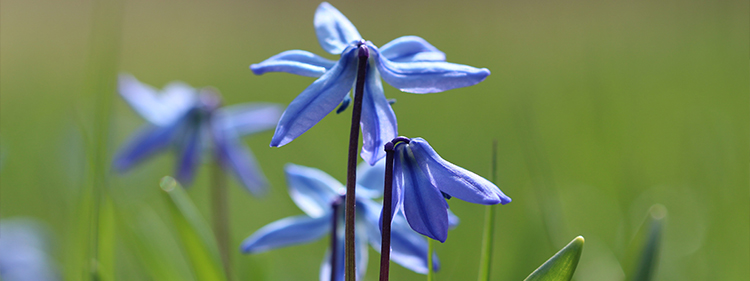
Amsonia tabernaemontana, commonly known as Willow Bluestar, Blue Dogbane, or Blue Star, is native to the Northern hemisphere so it is not surprising to learn that they can survive harsh winters. Amsonia plants emerge in spring and their foliage is willowy and grows in a cluster. Their flowers appear in late spring/early summer, they are blue, star-shaped and cover the plant.
When grown in moist soils, Amsonia plants require plenty of sunlight. In well-draining soils, they will do fine with partial shade. However, too much shade might prevent the plants from reaching their full potential as they will tend to sprawl. The ideal soil for Amsonias is hummus-rich covered in a layer of mulch.
Japanese Anemone

If you’re looking for the perfect flowers to put a show in your garden from late summer to early autumn, Anemone hupehensis a.k.a. Japanese Anemones are a perfect choice. These hardy ornamental plants have attractive foliage and pale pink and white flowers that grow in tall stems.
Japanese Anemones don’t need much to grow healthy and happy. Just make sure to plant them in well-draining soil and to provide them with some shade over the summer months. Japanese Anemones are not very picky when it comes to their soil, but they do have one enemy – wet soil during the cold winter months.
Butterfly Weed
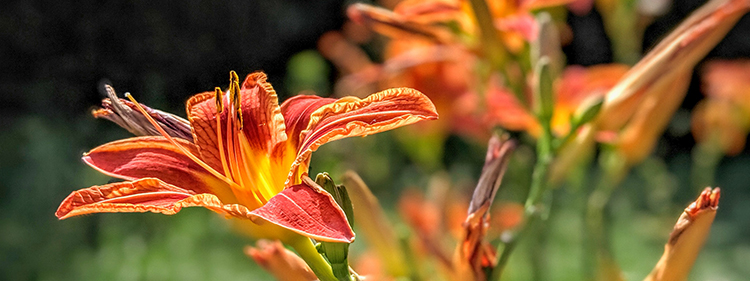
Asclepis tuberosa, commonly known as Butterflyweed, Milkweed, or Orange Milkweed is a bushy perennial that produces attractive orange blooms. The flowers of Butterfly Weed grow in clusters and they are very appreciated by gardeners for many reasons. As the name suggests, Butterfly Weed attracts butterflies and other beneficial pollinators. Plant your Butterfly Weed in early spring to enjoy its attractive blooms in late summer and early autumn.
Being a native wildflower, Butterfly Weed is easy to grow and it is not very picky when it comes to its growing conditions. All it needs to thrive is plenty of sunlight, any type of soil, and a moist soil environment.
Clematis
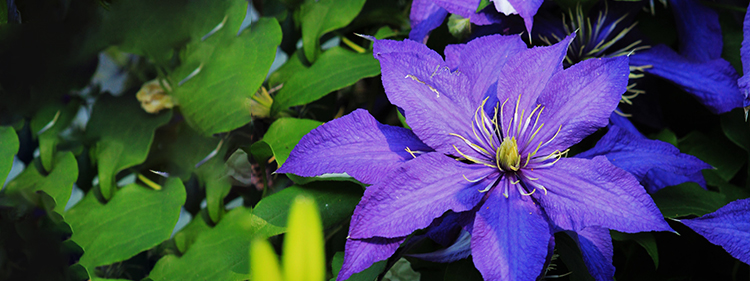
Everyone falls in love with Clematis flowers at first sight. Once you see the blooms of Clematis plants, you won’t be able to resist bringing them into your garden. But producing attractive and colourful flowers is not the only advantage of Clematis plants. They are also very hardy and low maintenance.
To grow healthy and happy Clematis plants, plant them in a sunny spot. If you are out of sunny spots in your garden, you’ll be happy to learn that there are some cultivars that can thrive in partial shade, such as Henryii and Nellie Moser.
When it comes to soil, Clematis plants prefer soil that has a neutral to alkaline pH, that is well-draining, and that is kept constantly moist.
Delphiniums
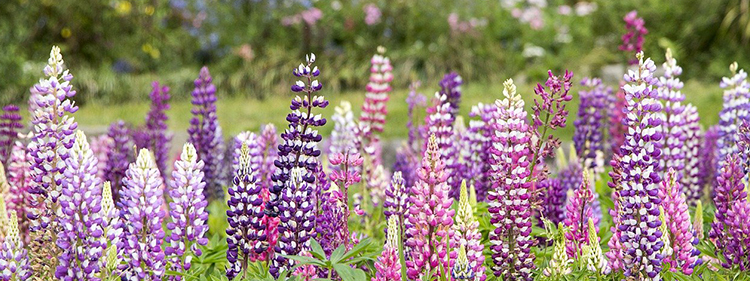
Delphiniums are hardy perennials that produce showy flowers in all the colours of the rainbow. If you’re a fan of cottage gardens or if you’d like to enrich your garden with many elegant blooms, Delphiniums are a great option.
It is very important to remember that Delphiniums won’t do well in extreme summer weather as they are not fans of drought, scorching sun, or heat. To thrive and to reward you with their attractive blooms, provide your Delphiniums with moist, fertile, well-draining soil, shelter from strong winds, and plenty of shade over the hot summer months.
Echinacea
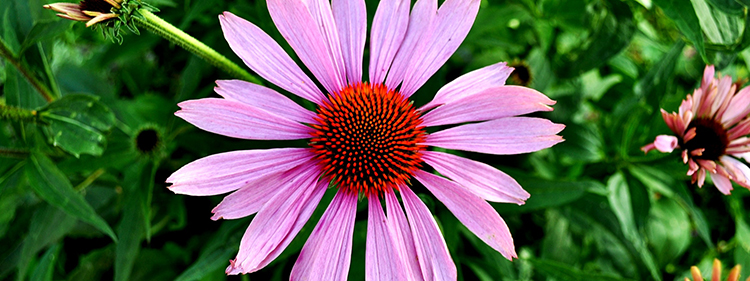
Commonly referred to as Purple Coneflower, Echinacea Purpurea is a hardy and easy to grow perennial. The best thing about this plant is that it doesn’t mind drought and it can survive cold winters and very hot summers. In addition to that, Echinacea plants bloom sporadically so you’ll be able to enjoy their colourful flowers for many months.
These sun-loving plants will be grateful if you plant them in the sunniest spot of your garden, as long as they get some shade in the afternoon to prevent sunburn. Like most flowering plants, Echinacea attracts plenty of butterflies and other beneficial insects. In terms of watering, they typically need weekly watering but even less than that if it rains.
Hibiscus

Hibiscus plants give a tropical look to any garden. They are attractive, easy-to-grow, and can be grown both outdoors and indoors in containers. Hibiscus plants need at least six hours of sunlight every day, so make sure you place them in a sunny spot in your garden.
Being native to tropical environments, Hibiscus plants will thrive in warm and humid environments. But like all flowering plants, the scorching sun can damage their delicate foliage and blooms, so make sure they get some shade as well.
Water your hibiscus plants generously, especially during their blooming period, but avoid waterlogging. In warm weather, these plants may require daily watering, but only if the soil dries out.
Liatris Spicata
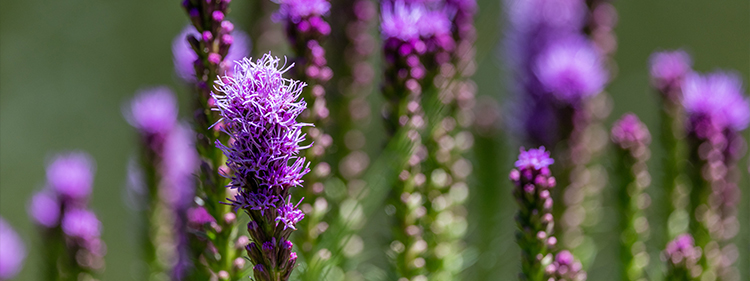
Also known as Blazing Star or Prairie Star, Liatris Spicata is a hardy perennial that will spruce up your garden with its brightly coloured flowers. The unique-looking flowers of Liatris Spicata have a wildflower appearance and they adorn gardens from mid-summer to autumn. If you enjoy growing beautiful flowers and using them to create bouquets, Liatris Spicata is a perfect addition.
To grow healthy and happy Liatris plants, grow them in full sun and light shade and well-draining soil. Waterlogging is the biggest enemy for these plants as they have a higher tolerance for drought than they have for moist environments. However, new plantings should be watered weekly, until they develop a strong root system. Mature plants can be neglected as they become tough and start showing their tolerance for harsh growing conditions.
Hardy Plants for Hot & Dry Climates
Gardening in Australia is a fun and rewarding activity, especially if you choose the right plants for your garden. As we all know, some regions can get extreme heat and droughts, which is not ideal for a lot of plants. But, luckily for us, there are many attractive plants that will survive this harsh environment. Here are some of our favourites:
Coprosma
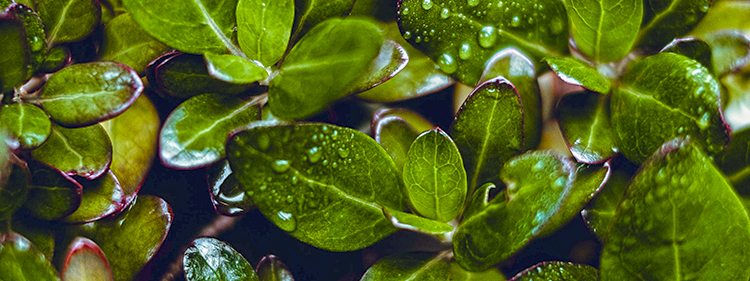
Native to New Zealand, Coprosoma is a creeping plant with a fun feature that can be deduced from its name (which literally means ‘dung smell’). Its leaves have an unusual smell, but the plant has nice-looking foliage, white flowers, and orange fruit (edible and quite tasty). It thrives in coastal areas and it doesn’t mind salt spray and droughts.
The idea of growing conditions for Coprosoma consists of sandy soils with good drainage and plenty of sunlight. This plant is not toxic to animals and it doesn’t really attract pests, so you can grow it easily and without much effort.
Metrosideros Tahiti
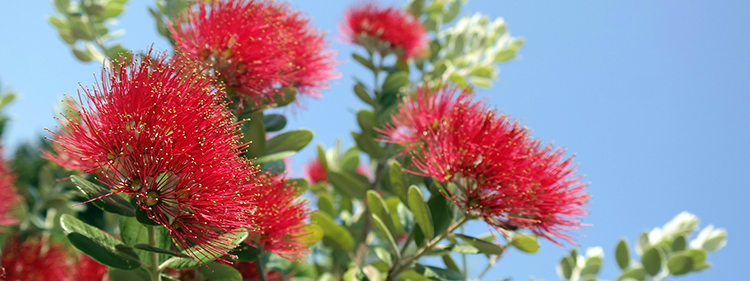
The red fluffy flowers of the Metrosideros Tahiti are just a bonus to its amazing resilience in the face of wind, drought, extreme heat, and scorching sun. This medium-sized evergreen shrub will spruce up any garden regardless of the growth conditions. Metrosideros Tahiti can tolerate any type of soil, from moist to dry and doesn’t mind exposed coastal sites.
As mentioned above, Metrosideros Tahiti produces attractive blooms and the best thing about them is that they appear sporadically throughout the year. The average size of a Metrosideros shrub is around 1 m high and 1.5 m wide.
Agapanthus
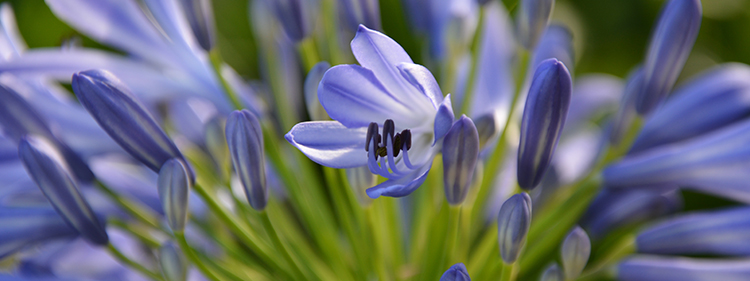
Also known as the ‘African Lily’, Agapanthus is a tropical-looking perennial that thrives in warm environments. Agapanthus are native to South Africa, and are a custom to being exposed to plenty of direct sunlight. Although it can survive drought, Agapanthus will reward you with its beautiful blooms if you keep its soil fertile and moist.
Agapanthus plants require a soil temperature of around 10°C. Therefore the ideal time to plant them is in Spring, when the danger of frost has passed. These plants need as much nutrition as they can get so it’s best to add some organic compost to their soil when you plant them.
Achillea
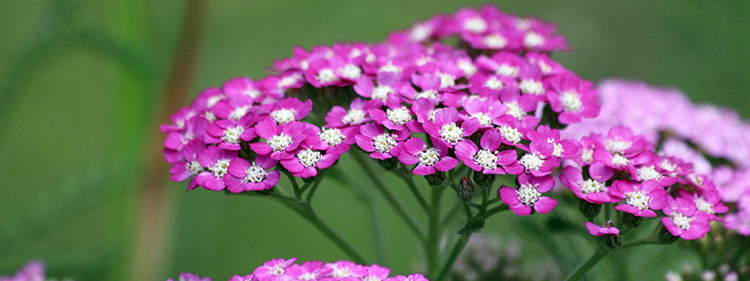
This plant goes by many names including Yarrow, Carpenter’s Weed, or Milfoil. Valued by gardeners for centuries, this plant smells nice and has attractive foliage and long-lasting white flowers. It thrives in almost any environment and it is perfect for meadow gardens, rock gardens, cottage gardens, prairies, and herbaceous borders.
Achillea can thrive in any type of soil from acidic to alkaline and from fertile to sandy. It does prefer well-draining soils and needs plenty of sunlight. It blooms from late spring to late summer, so you’ll get to enjoy its flowers for many months and it attracts butterflies and other beneficial pollinators.
Butterfly Bush
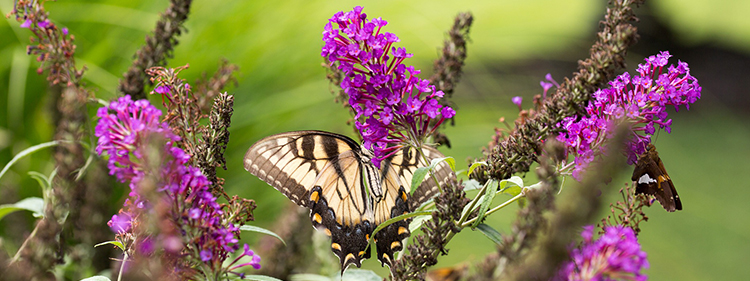
Buddleia Davidii a.k.a. The Butterfly Bush is a deciduous shrub that grows fast and that produces masses of elongated and colourful blossoms during the summer months. Butterfly Bush comes in many different colours, but gardeners seem to think that butterflies are more attracted to the lavender-pink ones, which are also easier to come by.
Being a fast-growing plant that can tolerate any growth conditions, the Butterfly Bush can be a bit invasive, so make sure you plant it within a safe distance from other valued members of your garden. The ideal growing conditions for Butterfly Bush include well-draining fertile soil, plenty of sunlight, and generous watering.
Delosperma

Although the Delosperma is commonly known as the Ice Plant, this flower thrives in hot dry environments. It will do just fine in temperate and cold regions as well, so it’s safe to say that you can plant it anywhere. Delosperma is a mat-forming, vigorous evergreen succulent that produces pink daisy-shaped flowers. This plant will produce blooms continuously from the beginning of summer and through fall, so you’ll have plenty of time to enjoy its lovely appearance.
The ideal growing conditions for Delosperma consist of dry, well-drained soils, plenty of sunlight, and very little water. This plant doesn’t like to have wet feet, so make sure you plant it in sandy or even gravelly soils. It doesn’t attract pests, but it does attract butterflies and other pollinators.
Dianthus
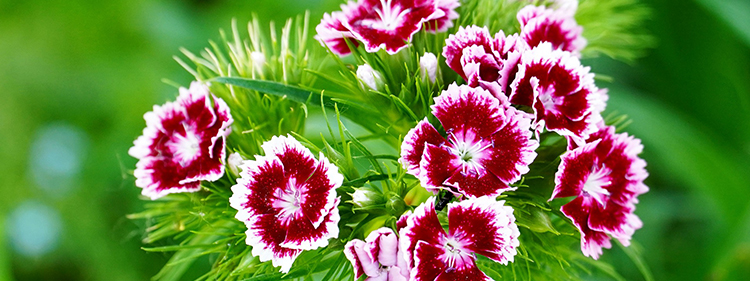
Dianthus plants are closely related to carnations and they are just as attractive. Commonly known as ‘pinks’ or ‘Sweet William’, these plants produce beautiful blooms that have a spicy scent quite similar to cloves or cinnamon. You can find different cultivars on the market, some of them being hardy annuals, some biennials, and others are perennials, so there are plenty of options to choose from.
Most Dianthus cultivars bloom sporadically from late spring to early autumn. To produce as many flowers as possible, make sure you provide your Dianthus plants with at least 6 hours of sun every day and some shade in the afternoon, well-drained soil that’s fertile and alkaline, and watering when the soil seems dry.
Globe Thistle
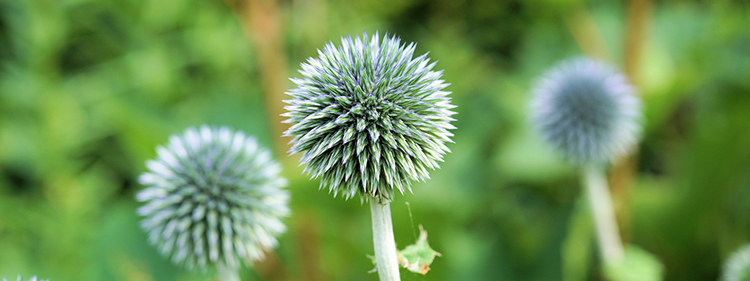
You may know of the Glob Thistle as they can sting, and they tend to attach themselves to your clothes or to your pet’s fur. However, they also come with some pretty compelling advantages. They have an exciting and unique appearance, their blooms are colourful, and they can grow anywhere.
With minimal care, Globe Thistle will thrive and will reward you with its cute blooms. All you need to do is plant them in a sunny spot, and nature will do the rest. They won’t mind dry soil and drought, and won’t attract pests. If you’re a fan of meadow gardens filled with native plants that attract beneficial pollinators, you should add Globe Thistle to your shopping list.
Euphorbia
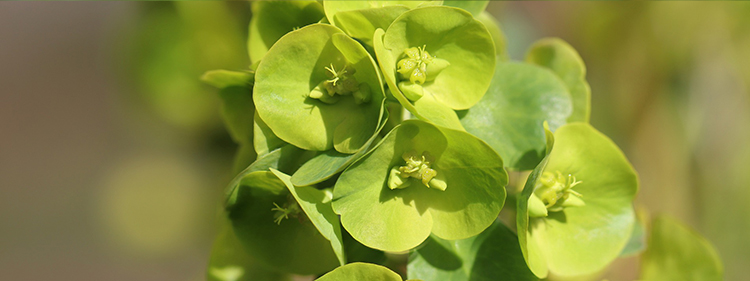
Euphorbia is a very large family of flowering plants valued for their unique appearance, beautiful flowers, and low-maintenance nature. Euphorbias have succulent leaves that store water and help the plants withstand droughts and extreme temperatures. Some Euphorbias look quite similar to cacti such as Euphorbia enopla, Euphorbia ferox, or Euphorbia mammillaris, while others look like tropical plants and produce beautiful flowers.
Due to their great tolerance for heat, Euphorbias can be used in xeriscaping, rock gardens, and in any heat-affected garden. The most important thing to remember about Euphorbias is that they are very sensitive to root rot and too much humidity in their soil can be fatal.
For outdoor gardens, we recommend Euphorbia Silver Spurge, Euphorbia Sticks-on-Fire, Euphorbia cotinifolia, and Euphorbia x martinii.
Gaillardia
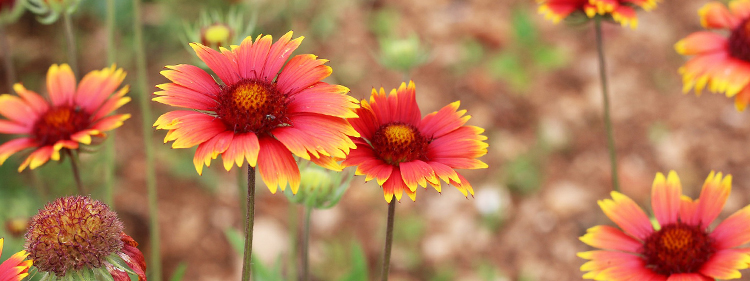
Gaillardia is commonly referred to as the ‘blanket flower’ thanks to its vivid colours that remind us of the traditional Native American blankets. There are three main types of Gaillardia cultivars available on the market – G. Pulchella, G. Aristata, and G. x Grandiflora. All three have similar growth requirements, the only notable difference being the fact that G. Pulchella is an annual plant, and the other two are perennials.
Gaillardia plants don’t need much to thrive, and they can fend for themselves. As long as you plant them in a dry, sunny location, they will reward you with their colourful blooms. You can plant them anywhere, even on rocky hillsides, and they will be fine.
In general, rainwater is enough for them, even during the hot summer months, and they don’t need any extra watering. Also, they are not fans of fertilizing, so there is no point in trying to encourage their growth. It’s best to let them do their thing without too much interference.
Helleborus
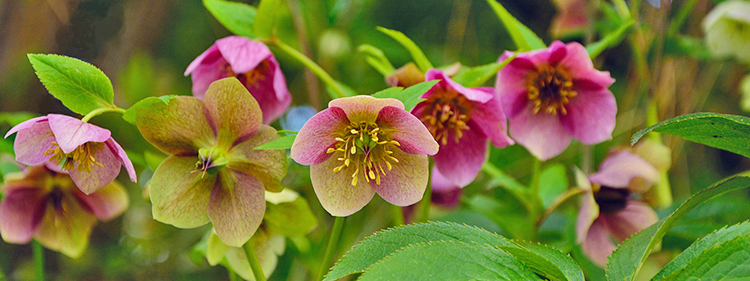
Commonly known as Hellebore flowers, Helleborus plants have grown in popularity in recent years thanks to hybridization. The new and improved Helleborus cultivars are easy to grow and to care for and thrive in many different types of environments. The most popular species of Helleborus plants are H. Orientalis (Lenten rose), H. foetidus (stinking hellebore), and H. niger (black rose or Christmas rose).
These perennial flowers bloom in early spring and their blossoms are absolutely stunning. In warm climates, Hellebores can bloom in early winter, so they are sometimes called Christmas roses. Hellebores thrive in rich, moist soil and partial to full shade. They love warm environments, but they are not big fans of drought or sunshine, so choose their location carefully.
Kniphofia
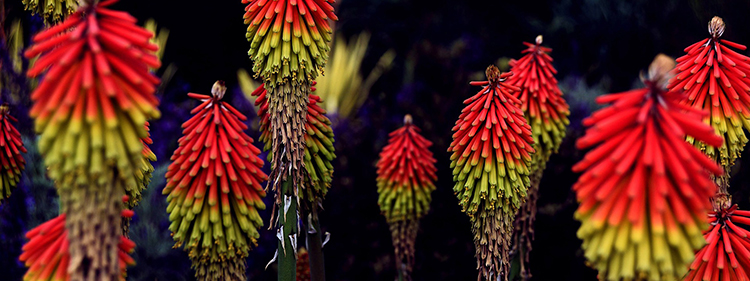
Also known as poker plant, torch lily, or tritoma, Kniphofia is a perennial flowering plant native to the African continent. Its tropical appearance will give your garden an exotic vibe without too much effort on your part. The spectacular flowers of Kniphofia change their colours as they mature which is why they often seem to be bicolour.
The ideal growth conditions for Kniphofia include well-draining, sandy soil (enriched with hummus if possible), and full sun. They can survive in other conditions, but they won’t produce as many flowers as they would in the previously mentioned scenario.
Lavender
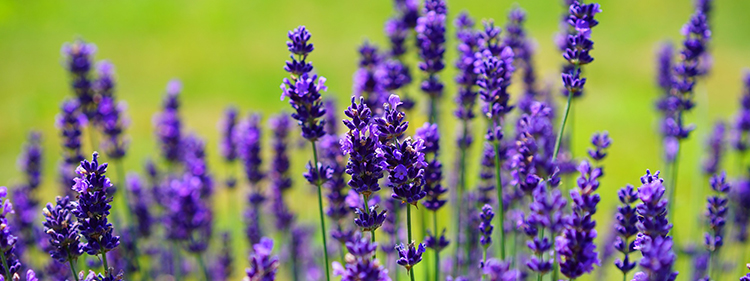
We all love lavender – it has an amazing smell, its flowers make us think of endless purple fields and cottage gardens, and it is a plant that has many health benefits. Planting lavender in your garden is the best decision that you can possibly make. It is a low-maintenance plant that thrives in well-draining soil and loves to get plenty of sunlight.
Lavender thrives in hot climates, being a sun-loving Mediterranean plant. As mentioned above, lavender can grow anywhere. It is not picky when it comes to soil conditions, its only enemy being too much moisture.
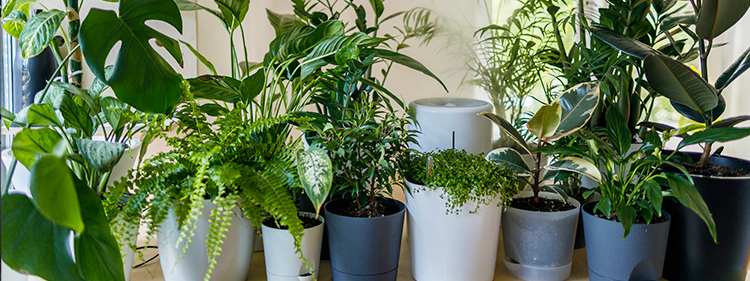
You don’t need to have a big garden to plant beautiful flowers. There are plenty of solutions to bring nature into your home. Whether you want to grow succulents and cacti, plants that produce edible fruit, or plants with beautiful blooms, you can do so by planting them in hanging baskets and pots.
Here are some of our favourite hardy plants that you can grow in pots and hanging baskets:
Aechmea

Aechmea fasciata a.k.a ‘Silver Vase Plant’ or ‘Urn Plant’ is a Bromeliad – monocot flowering plants. It is grown natively in the subtropical regions of America and in Africa. Being tropical flowers, Aechmeas produce stunning blossoms, have exotic foliage and thrive when grown in containers.
The ideal growth conditions for Aechmea fasciata consists of plenty of bright, but indirect light, a moderate amount of water, and a well-draining soil mix. When it comes to Bromeliads, the watering routine is quite unique. They need to get water in their urn, which should get flushed regularly, they enjoy having their leaves sprayed with water, and they also like their soil a little moist.
Blueberries
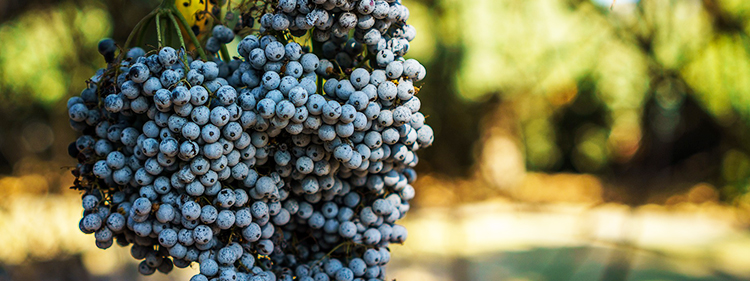
If you don’t have enough space in your garden and you want to start growing delicious blueberries, we have the perfect solution for you – growing blueberries in containers. If you want to harvest blueberries over several months, you can do so by planting different varieties. There are three different types of blueberry bushes: low bush, high bush, and a hybrid half-high bush. The most common variety is the high one, but you should choose the one that suits your needs best.
The ideal growing conditions for blueberries consist of well-draining soil that is acidic and dressed with plenty of organic matter. As a general rule, container blueberries need about 3-5 inches of water per week.
Bougainvillaeas
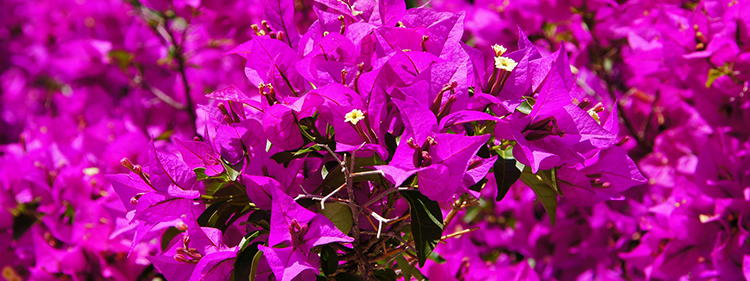
Bougainvillaeas are hardy tropical vines that can be grown in temperate and warm regions. You can grow them in containers, and you don’t really need to worry about the surrounding environment. The best thing about potted plants is that when it gets cold, you can bring them inside. This way you can continue to enjoy their beauty. This applies to Bougainvilleas, which can easily be grown in small containers because they thrive when their roots are restricted.
These stunning plants will reward you with their blooms as long as you provide them with regular potting soil. Be sure to consider a container with drainage holes, some support such as a trellis, and regular watering.
Mexican Orange Blossom
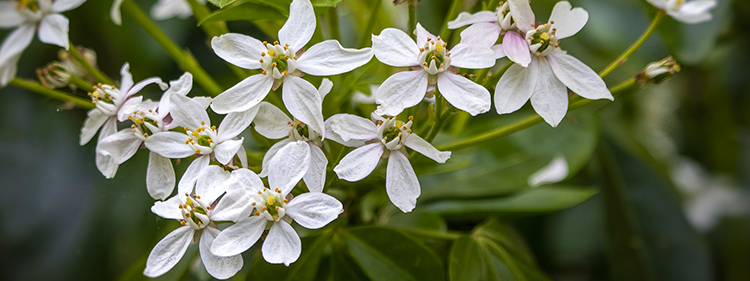
Choisya ternata, commonly known as Mexican Orange Blossom is a moderate-sized perennial native to Mexico. Gardeners love to grow this plant both outdoors and indoors because it has a pleasant scent. It also has attractive foliage and blooms.
The Mexican Orange Blossom shrub can grow quite big – up to 2 meters by 2 meters, so choose its location carefully. When grown in pots, this plant requires a well-draining acidic soil mix combined with peat moss, lots of natural light, and daily watering in summer.
Wisteria
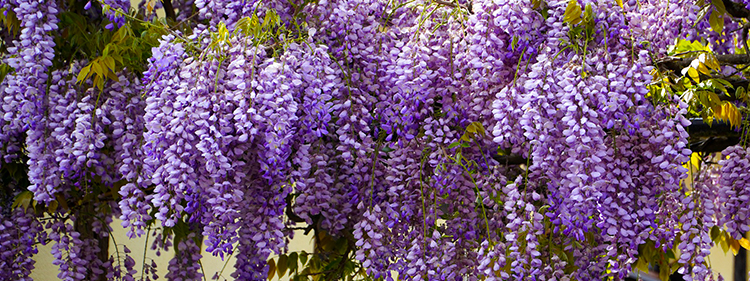
Wisteria is a spectacular deciduous climbing shrub that produces lavender pendant-like flowers that have a pleasant smell. They also appear in late spring to early summer. This plant grows best when placed near a wall, or in a place where it will have plenty of support. It needs moist soil that is well-draining.
This plant needs a lot of space as its roots and vines are pretty strong. However, if you can’t grow it in your garden, you can surely try planting it in a container. Prune it regularly to keep it a manageable size and make sure you offer it sturdy support. Don’t let it climb pergolas or other fragile materials as they might break under its weight.
Clivia

Also known as Fire Lily, Bush Lily, or Native Lily, Clivia is a genus of flowering plants native to southern Africa. Clivias are herbaceous evergreen perennial plants that come in many colours, shapes, and sizes. Most clivias, however, are yellow, orange, and red.
Although Clivias are often planted directly in the garden bed, few people know that these tropical plants thrive in pots. Why is that? Because Clivias thrive when their roots are restricted as they get to redistribute their energy towards their foliage and blooms.
Clivias thrive in temperatures between 18°C and 25°C during their active growth period. However, they need cooler temperatures during their dormancy period. They prefer rich, well-draining soil and bright but indirect light.
How Can We Help Our Plants Become Hardier
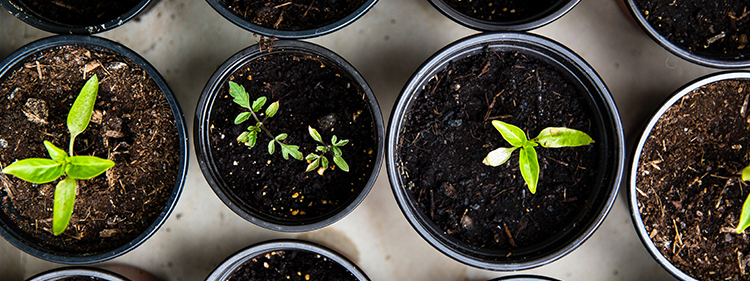
The way in which our plants react to extreme weather is influenced by the conditions found in our gardens. It is important to be aware of our surrounding environment and the growth conditions that we offer our plants. To help our plants become more resistant, we have to consider the soil, the amount of shade, cold droughts, temperature fluctuations, humidity, and so on. All of these elements are part of the unique microclimate of our garden and understanding them will enable us to make informed choices, to choose the appropriate plants, to position them correctly, and increase their chances of survival.
Read on to find out how to help your plants be more resistant and better adapted to the conditions found in your garden.
Improve soil drainage
The soil conditions of our garden are a very important aspect. Plants are most vulnerable to soil problems during their dormancy period that usually occurs during the cold winter months. When plants go dormant, their roots become less active and, thus, unable to absorb moisture from the soil. A prolonged period of cold and wet soil can cause the plants to drown. The good news is that we can avoid this situation by improving soil drainage over the cold months. In well-draining soil, plants will become more cold-hardy.
Protect the roots
Frost can damage the roots of our plants, which can become more vulnerable when temperatures are fluctuating. To protect our plants from frost, we can insulate their root system by spreading a layer of mulch around their base. Well-rotted mulch will keep the soil at a constant temperature, thus keeping the frost at bay.
Provide shelter
Walls, fences, and other similar structures can provide our plants with much-needed shelter when facing cold winds. Draughts and winds can cause the leaves to dry out, leaving our plants vulnerable over the cold months. To prevent the cold wind from drawing all the moisture out of our plants. We can use the structures that are already present in our garden and we can also add mini-shelters made of twigs or fleece.
Shade
The great majority of plants will suffer sunburn if they are exposed to the hot afternoon sun. While all plants enjoy the nice morning sun, they can be severely damaged by the scorching sun, especially if they have thick leaves or if they flower in early spring. So, the best thing to do is to ensure that your plants get plenty of light in the morning and some shade in the afternoon.
Resources
https://www.gardenexpress.com.au/australian-climate-guide/
https://www.anbg.gov.au/gardens/research/hort.research/zones.html
https://www.gardenia.net/guide/australian-hardiness-zones
https://www.ambius.com/blog/plants-that-survive-winter/
https://www.rhs.org.uk/advice/profile?pid=787
https://www.abc.net.au/gardening/factsheets/frost-tolerant-plants/942896
https://www.youtube.com/user/BetterHomesAus
https://www.youtube.com/channel/UCzzsltdnAgTMSlPOvjko_Dw
https://www.australianplantsonline.com.au/tubestockplants/natives.html
https://www.australia.com/en/facts-and-planning/about-australia/australias-plants.html

